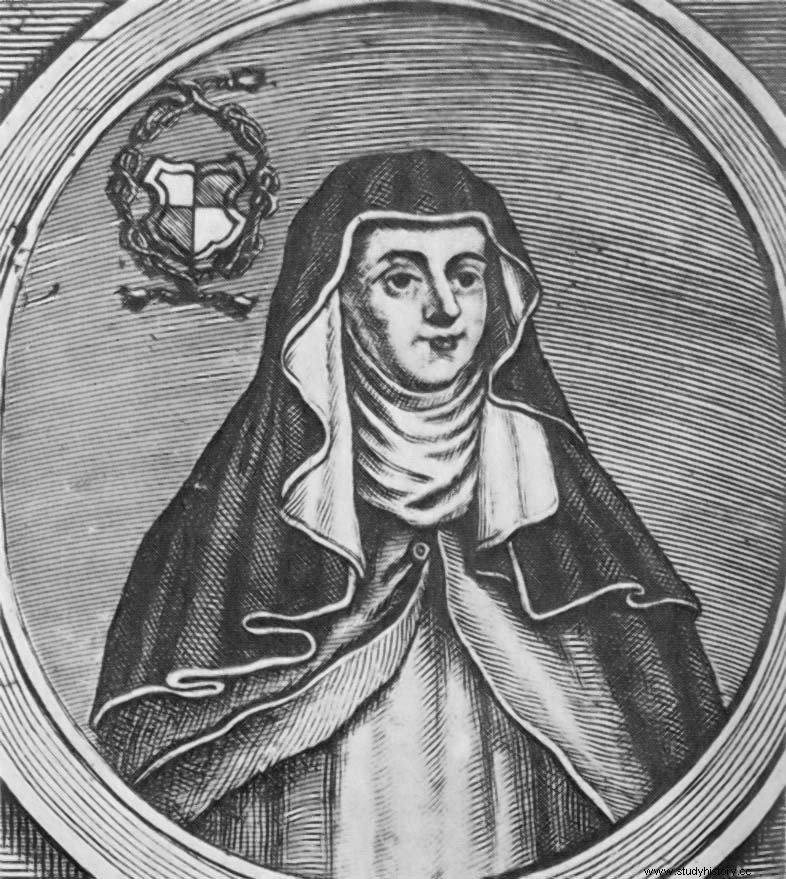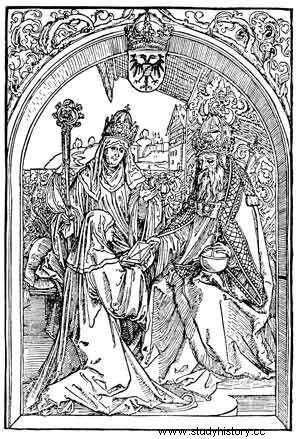Nun from Saxony, Hrotsvita of Gandersheim (between 930 and 935 – after 973) wrote spiritual or historical works in Latin, and six of the rare plays composed in the Middle Ages. She is considered the first Germanic author.
An educated child

The life of Hrotsvita of Gandersheim is poorly known, the main sources being his own writings. Regarding her date of birth, she indicates in her historical poem “Carmen de Primordiis Coenobii Gandersheimensis” that she was born long after the death of the Duke of Saxony Otto I st of Saxony, died in 912. His birth is estimated between 930 and 935, within a family of the Saxon nobility. She was born in the Duchy of Saxony, within the Kingdom of Germania.
Educated and cultured, Hrotsvita may have been trained alongside Brunon, younger brother of King Otto of Germany, who would become the first emperor of the Holy Roman Empire. She was a pupil of Gerberge, daughter of Duke Henry of Bavaria, who became abbess of Gandersheim Abbey in 949, today in Lower Saxony in Germany. At the time, the abbey, comprising a place of reception for travellers, a hospital, a library and a school, was a real place of knowledge and the dissemination of culture; many noble families send their children there to be educated. In the middle of the golden age, the abbey was so influential that it obtained the authorization to dispense justice, to have an army and to mint coins.
Historical writer
The date of Hrotsvita's entry into Gandersheim Abbey is no better known than his date of birth. Her writings suggest that she does not take the veil immediately, but that she has some experience of secular life. Be that as it may, Hrotsvita began her first literary works in the years 950 – 960. At the request of Abbess Gerberge, she wrote the Gesta Oddonis , a very important source on the reign of the Ottonian Germanic kings since 919.
Hrotsvita de Gandersheim also works to retrace the history of the abbey, founded in 852 by Count Liudolf of Saxony and his wife Oda after a pilgrimage to Rome. In addition to six hundred worms, the Primordia coenobii Gandeshemensis strive to enhance the abbey, faced with the rise of its neighboring rival Quedlinburg. The nun also composed lives of saints, such as Agnes of Rome, Pelagius of Cordoba or Denis of Paris. Dividing his oeuvre into three books, Hrotsvita compiles his hagiographies in his Book of Legends , integrated into his Liber Primus (Book One).
Plays and comedies

Within the work of Hrotsvita de Gandersheim, the greatest originality resides in her plays, Gallicanus , Dulcitius , Callimachus , Abraham , Paphnutius and Sapientia . Inspired by the ancient poet Terence, whom she read during her studies at the abbey, Hrotsvita appropriates a genre almost forgotten since antiquity. Featuring rather endearing heroines, she talks about love and chastity, miracles and divine interventions, with a sometimes humorous and surprisingly modern tone.
Hrotsvitha knows that, as a woman, her work will be taken less seriously than if it came from a man. She herself does not seem to question the opinion of her time, that women are less apt at writing than men. To support her legitimacy as an author, she argues that she is an exception, inspired by God. She indicates that she "lays aside feminine weakness and invokes in her cautious heart a virile force" .
We do not know the circumstances or the date of the death of Hrotsvita de Gandersheim any more than those of his birth; in any case, she died after 973. Her works were forgotten in the Middle Ages, then rediscovered and republished around 1494. Considered the first Germanic writer, she was one of the rare authors of the Middle Ages.
